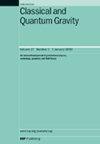标量张量非度规引力的额外自由度能否解释宇宙的演化?
IF 3.7
3区 物理与天体物理
Q2 ASTRONOMY & ASTROPHYSICS
引用次数: 0
摘要
我们研究了在标量张量非度规引力的第二类连接类中出现的额外标量自由度是否可以准确地复制和潜在地丰富宇宙膨胀历史。在空间平坦的friedmann - lema本文章由计算机程序翻译,如有差异,请以英文原文为准。
Can an extra degree of freedom in scalar-tensor non-metricity gravity account for the evolution of the Universe?
We investigate whether the extra scalar degree of freedom that arises in the second connection class of scalar-tensor non-metricity gravity can accurately replicate and potentially enrich the cosmic expansion history. Focusing on a spatially flat Friedmann–Lemaître–Robertson–Walker background, we introduce Hubble-normalized variables and recast the field equations into an autonomous dynamical system. Four representative scenarios are analyzed comprehensively. Phase-space research reveals a rich hierarchy of critical points: matter-dominated, stiff-fluid, and de Sitter solutions, together with asymptotic trajectories leading to Big-Crunch/Rip singularities and transient, unstable matter epochs. With suitable parameter choices, the standard ΛCDM sequence is reinstated; however, novel late-time and high-curvature regimes arise exclusively from the non-metricity sector. A systematic comparison of metric scalar-tensor and teleparallel scalar-torsion theories reveals unique stability characteristics and potential observational discriminants. Our findings indicate that the additional time-dependent function inherent to scalar-tensor non-metricity gravity can effectively explain the Universe’s evolution while providing new phenomenology that can be tested by upcoming surveys.
求助全文
通过发布文献求助,成功后即可免费获取论文全文。
去求助
来源期刊

Classical and Quantum Gravity
物理-天文与天体物理
CiteScore
7.00
自引率
8.60%
发文量
301
审稿时长
2-4 weeks
期刊介绍:
Classical and Quantum Gravity is an established journal for physicists, mathematicians and cosmologists in the fields of gravitation and the theory of spacetime. The journal is now the acknowledged world leader in classical relativity and all areas of quantum gravity.
 求助内容:
求助内容: 应助结果提醒方式:
应助结果提醒方式:


